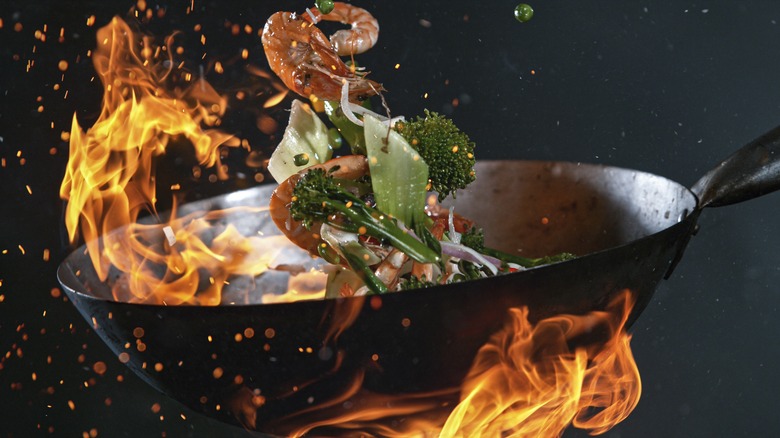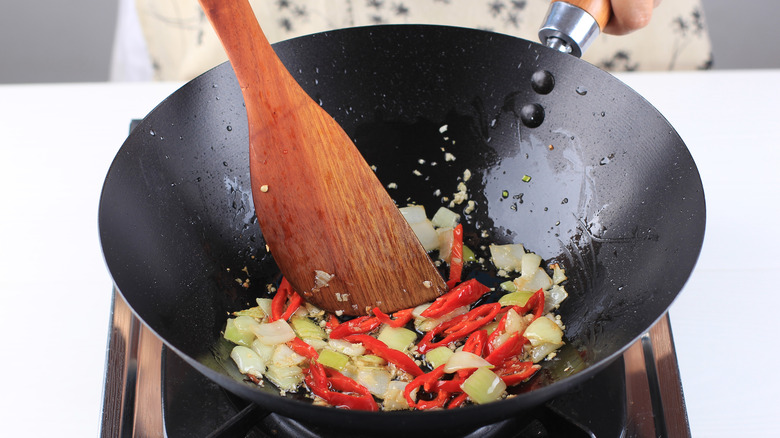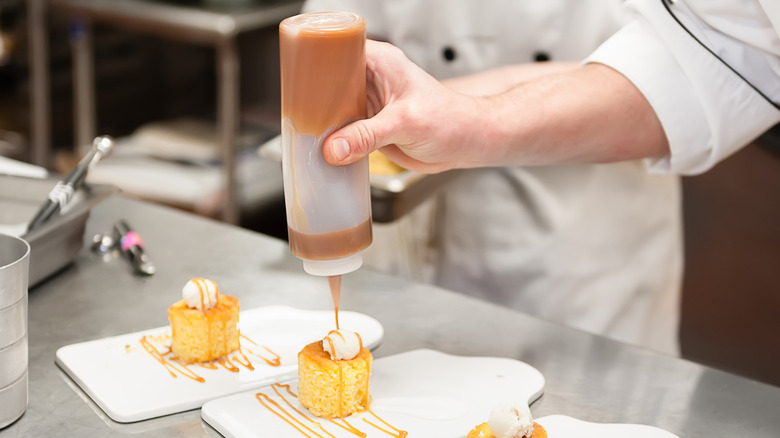Why You Should Always Keep Your Wok Oil In A Squeeze Bottle
Cooking with a wok is a live-wire, exciting event. You need to cook food rapidly over very high heat, tossing your ingredients to achieve a perfect crispness and the smoky char known as wok hei, or "breath of the wok." Doing this successfully requires carefully-prepared ingredients — and that includes the fat you'll use as your cooking medium. One of the easiest ways to up your wok game is to keep your cooking oil in a squeeze bottle.
This method has several advantages over pouring oil straight out of its original packaging. A squeeze bottle allows you to control the flow of your oil much better than an open-capped bottle does. This is super important when you're stir-frying in a wok, since if you add too little oil, your food will stick and become unpleasantly burned. Add too much, however, and you end up with a soggy, greasy meal. The thin spout of a squeeze bottle makes it much easier to manage how much oil hits the wok, without overdoing it.
It's also important to coat the entire surface of the wok when you cook with it. This keeps food from sticking to the edges, and it also helps to season the wok and create an semi-nonstick coating over multiple uses. This is referred to as seasoning a wok. With a squeeze bottle, you can easily drizzle oil all over the sides of the vessel with far more precise control.
More wok cooking tips
It's important to get all of your prep work done before you heat up your wok. Once you start cooking, things move fast, so you can't spare a moment to prepare ingredients you forgot about. Start by cutting up your veggies, proteins, and other ingredients into uniform, bite-sized pieces, so that everything cooks evenly. Put each ingredient in its own bowl, and keep them within reach of your stove.
You should cook your ingredients in batches when using a wok at home. Chinese restaurants use gas ranges that burn far hotter than a Western-style home stove, so cooks can dump in all of the ingredients and cook them perfectly. If you do this at home, the temperature of your wok will plummet, resulting in soggy, under-browned food. By cooking in batches, you ensure that the pan stays nice and hot and gives everything a proper sear.
Preheat your wok until it's almost smoking before adding the oil. Once you've added your first batch of ingredients, toss the pan and push the food around with a wooden spoon. When you toss the food, oil particles clinging to each ingredient vaporize, giving you a pleasantly smoky flavor. Doing this allows you to create as much wok hei as you can. Once each ingredient is cooked to tender-crispness, return all the ingredients to the wok, add your sauce, and toss to combine.
Other great uses for squeeze bottles
Squeeze bottles aren't just helpful when you're stir-frying — they come in handy throughout the kitchen. Whether you're cooking in a wok or not, having control over how much oil you use is always helpful, whether you're simply sautéing or using expensive olive oil to garnish a dish. Not only can you control exactly how much high-quality oil you use, but you can drizzle decorative patterns on your food. Try a simple cross-hatch pattern for a neat effect.
You can store other sauces and condiments in a squeeze bottle, too. They're an especially great option for salad dressings. Just keep your dressing in a bottle in the fridge, pull it out when needed, shake well, and squeeze it into your salad with ease. The same is true of homemade BBQ sauce, caramel sauce for desserts, or anything else you can think of. And if you want to avoid having to fix broken mayonnaise or a homemade aioli, use a squeeze bottle to slowly drizzle in oil as you whisk the other ingredients. Greater control over adding the oil helps the condiment emulsify smoothly.
As a final note, keep a permanent marker and a roll of masking tape in your kitchen to label anything you're putting into a squeeze bottle. This will help you stay organized and keep track of your ingredients, especially if you buy opaque bottles.



